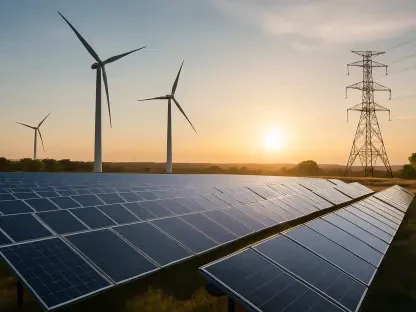Diving into the complexities of environmental law and federal funding disputes, I’m thrilled to sit down with Christopher Hailstone, a seasoned expert in energy management, renewable energy, and electricity delivery. With his deep understanding of grid reliability and utilities, Christopher offers unparalleled insights into the ongoing legal battle over the $14 billion Greenhouse Gas Reduction Fund (GGRF) grants, frozen by the EPA earlier this year. In this conversation, we explore the significance of the GGRF, the reasons behind the funding freeze, the judicial rulings that have shaped the case, and the broader implications for environmental policy and congressional legislation. Join us as we unpack the intricate details of this high-stakes dispute and what it means for the future of green initiatives in the United States.
Can you start by shedding light on what the Greenhouse Gas Reduction Fund is and why it holds such importance for the nonprofits involved in this legal battle?
Absolutely, Silvia. The Greenhouse Gas Reduction Fund, or GGRF, is a landmark program established under the Inflation Reduction Act to provide billions in grants for projects aimed at cutting greenhouse gas emissions. Think of it as a financial engine for green innovation—funding everything from renewable energy projects to infrastructure upgrades in underserved communities. For nonprofits like the Climate United Fund and the Coalition for Green Capital, this $14 billion is a lifeline. It empowers them to drive climate solutions at a scale that’s hard to achieve otherwise, directly impacting health, economic security, and environmental justice. Losing access to these funds isn’t just a budgetary hit; it’s a blow to their mission and the communities they serve.
What prompted the EPA to freeze these $14 billion in grants earlier this year, and could you walk us through the key events that led to this decision?
Sure. The freeze came shortly after a shift in administration priorities, with the EPA acting under pressure from arguments tied to the incoming Trump administration. Early in the year, around late 2023, there was growing public and political criticism about the scale of the GGRF and how the funds were allocated. Just before the inauguration, the EPA modified the grant agreements to make termination harder, which sparked controversy. By early 2024, the EPA decided to halt the disbursement of the $14 billion, citing the need for oversight and management of such a massive public fund. This move was seen as abrupt by the grantees, setting the stage for the legal challenges that followed.
The U.S. District Court initially stepped in with a ruling against the freeze. What was the reasoning behind Judge Tanya Chutkan’s decision in April?
Judge Chutkan’s ruling in April was a significant moment. She granted an injunction against the EPA’s freeze, arguing that the agency had acted arbitrarily and capriciously. Essentially, she found that the EPA didn’t provide a clear, reasoned explanation for revoking the funds. There was no solid evidence or process to justify such a drastic step, which violated administrative law principles. Her decision emphasized that federal agencies can’t just pull the rug out from under grant recipients without due process, especially when billions of dollars and major policy goals are at stake.
However, the U.S. Court of Appeals overturned that ruling in a 2-1 decision on September 2. What were the core arguments the majority used to uphold the freeze?
The appeals court majority took a very different view. In their September 2 ruling, they argued that the district court was wrong to think the grantees had a strong chance of winning on their claims—whether regulatory, constitutional, or based on arbitrary action. They leaned heavily on the idea that this dispute is fundamentally about contracts, not broader legal or constitutional issues. They also pointed out that the public interest, represented by the government, deserved priority in ensuring proper oversight of such a huge sum of money. Basically, they saw the freeze as a justifiable precaution, not an overreach by the EPA.
The majority opinion framed this as a contractual issue, suggesting it belongs in the Court of Federal Claims. Can you explain what that means and why it’s a big deal in this context?
Certainly. When the majority says this is a contractual dispute, they’re arguing that the core issue is about the terms of the grant agreements between the EPA and the nonprofits, not a violation of broader laws or rights. They believe this kind of dispute falls under the jurisdiction of the Court of Federal Claims, which handles cases involving monetary claims against the federal government. Why does this matter? It shifts the battleground. District courts, like where Judge Chutkan ruled, can address constitutional or administrative law issues, but the Court of Federal Claims is narrower in scope. This reframing could limit the nonprofits’ ability to argue broader harms and might delay or derail their fight to unfreeze the funds.
In their petition for a rehearing, the plaintiffs argue that the appeals court’s decision goes against established law. What specific concerns are they raising?
The plaintiffs, including groups like the Climate United Fund, are pushing back hard. In their petition, they claim the appeals court’s ruling contradicts settled legal principles, especially on jurisdiction and constitutional claims. They argue that their case isn’t just about contracts—it’s about the EPA trying to dismantle the GGRF and undermine Congress’s authority over federal spending, which they see as a clear constitutional issue. They also challenge the idea that their claims don’t belong in district court, saying this interpretation misreads how administrative actions should be reviewed. It’s a plea to correct what they see as a dangerous precedent.
Judge Nina Pillard dissented strongly, criticizing the majority’s take on the Tucker Act. Can you clarify what the Tucker Act is and why she thinks they misinterpreted it?
The Tucker Act is a federal law that gives the Court of Federal Claims jurisdiction over certain claims against the U.S. government, particularly those involving money or contracts. Judge Pillard’s dissent argues that the majority stretched the Tucker Act too far, using it to block the district court from hearing the nonprofits’ broader claims about constitutional and statutory violations. She believes this is a misstep because the Tucker Act shouldn’t override the district court’s ability to address whether the EPA’s actions were lawful under administrative rules or the Constitution. In her view, the majority’s interpretation sets a troubling limit on where and how such disputes can be challenged.
Judge Pillard also warned that the government’s actions could cause lasting damage to major legislation. What specific harms are the plaintiffs worried about if the freeze persists?
Judge Pillard hit on a critical point, and the plaintiffs echo this concern. They’re worried that keeping the $14 billion frozen could permanently cripple the implementation of the Inflation Reduction Act’s goals. Without these funds, projects aimed at improving infrastructure, public health, and economic stability in communities nationwide could stall or collapse. We’re talking about renewable energy initiatives, green jobs, and pollution reduction efforts that might never recover from the delay. It’s not just about money—it’s about losing momentum on climate action at a time when every year counts.
The plaintiffs have requested a rehearing en banc, where all the judges of the court would weigh in. How do you see the odds of this happening, considering the court’s diverse makeup?
A rehearing en banc is a long shot, but not impossible. It means all active judges on the D.C. Circuit would hear the case, rather than just the three-judge panel. The court’s composition is varied—there are appointees from multiple administrations, including a mix of Obama, Biden, and Trump picks, among others. With only three Trump appointees out of the active judges, there’s potential for a broader perspective if the full court takes it up. However, en banc rehearings are rare and usually reserved for cases with major legal discrepancies or public importance. Given the high stakes of the GGRF and the split decision, they’ve got a case to make, but it’s far from guaranteed.
Looking ahead, what is your forecast for the future of federal funding disputes like this one, especially in the realm of environmental policy?
Honestly, I think we’re in for a bumpy road. Federal funding disputes, particularly around environmental programs like the GGRF, are likely to become even more contentious as political divides deepen. With environmental policy often caught in the crosshairs of administration changes, we could see more freezes, legal battles, and jurisdictional debates like this one. The outcome of this case could set a precedent for how much power agencies have to halt congressional mandates and how grantees can fight back. My forecast is that without clearer guidelines or stronger protections for such funds, we’ll see ongoing uncertainty, which could chill investment in green projects. It’s a critical moment for defining how environmental priorities are safeguarded in the face of political shifts.









